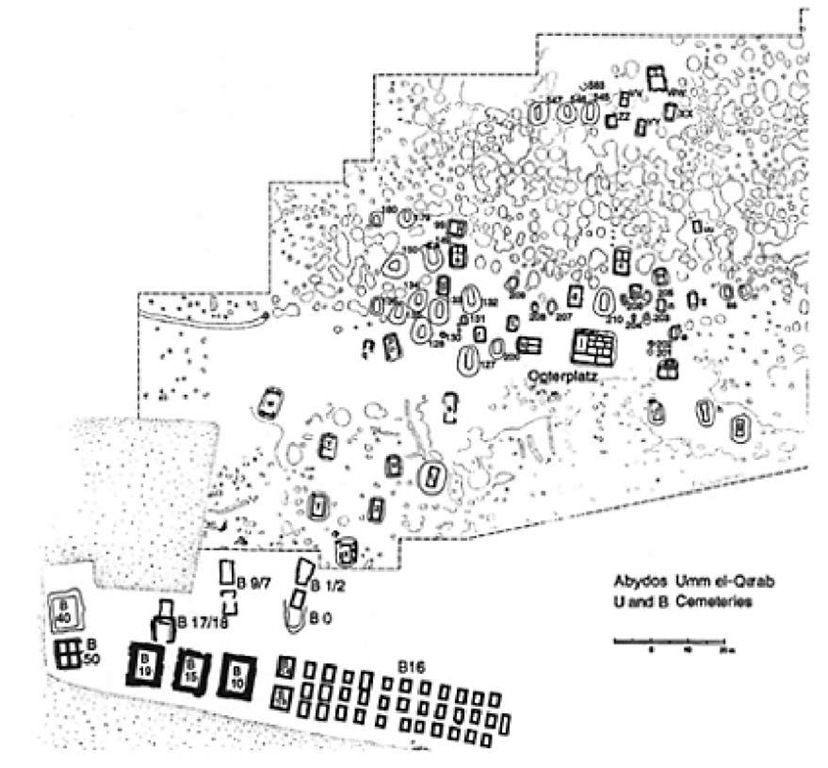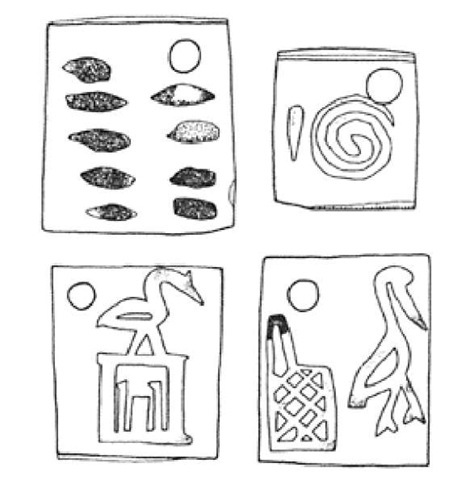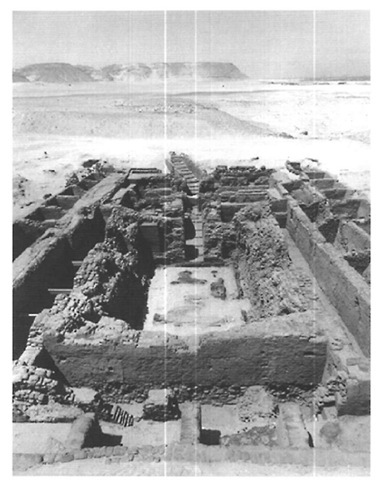Abydos, Umm el-Qa’ab
The Predynastic/Early Dynastic royal cemetery at Umm el-Qa’ab is located about 1.5km from cultivated land in the low desert (26°11′ N, 31°55′ E). To the east is a large wadi ending near the ancient settlement at Abydos known as Kom es-Sultan, next to the great funerary enclosures of the 1st and 2nd Dynasties.
The cemetery seems to have developed from north to south and consists of three parts:
1 Predynastic Cemetery U in the north;
2 Cemetery B with royal tombs of Dynasty 0 and the early 1st Dynasty in the middle;
3 the tomb complexes of six kings and one queen of the 1st Dynasty and two kings of the 2nd Dynasty in the south.
The cemeteries were first excavated by E. Amelineau in 1895-8. Flinders Petrie continued the excavation of Cemetery B and the later complexes in 1899-1900. Some parts of the cemetery were investigated again in 1911-12 by E.Peet and E.Naville. Since 1973 the German Institute of Archaeology (DAI) has been reexamining the entire cemetery. To date, parts of Cemetery U, Cemetery B and the complexes of Den (Dewen) and Qa’a have been re-excavated, and more limited investigations have been conducted at the subsidiary tombs of Djer and the complexes of Djet (Wadj) and Khasekhemwy. The complex of Den is being reconstructed.
From the very beginning, these tombs have been plundered many times and most of the 1st Dynasty tombs show traces of immense fires. The finds from the early excavations were in part sold (by Amelineau) and distributed to many collections. The most important ones are in Berlin, Brussels, Cairo, Chateaudun, Chicago (Oriental Institute), London (University College, British Museum), New York (Metropolitan Museum), Oxford, Paris (Louvre) and Philadelphia (University Museum). The artifacts found by the German mission are stored at Abydos.
Cemetery U
Cemetery U covers an area of circa 100x200m on a slightly elevated plateau between Cemetery B and the "heka-reshu" hill (where Petrie found New Kingdom shawabtis inscribed with this name). Amelineau reports excavating circa 150-60 graves of different types here (in four days!); 32 small graves were excavated by Peet in 1911. Both excavators published only a few details without a general plan.
During the clearance of the desert surface by the DAI, about 400 grave pits and hundreds of small empty offering pits (New Kingdom and later) were mapped. By 1993 about 120 tombs had been excavated, mostly in the central and southern part but a few at the northwestern edge. Ceramics are those of the Predynastic (Nagada) culture of Upper Egypt, which were first described and classified by Petrie and later revised in Nagada culture sub-periods by Werner Kaiser.
In Nagada I-IIa times Cemetery U seems to have been fairly undifferentiated, although there are a few somewhat rich burials. Thus far the Nagada IIb-c sub-period is underrepresented (there are almost no D-class pots), but in Nagada IId2 the cemetery had obviously developed into an elite one, with large tombs which were probably those of chieftains (and their kin). The multiple-chamber tombs (Nagada IIIa) and the larger single-chamber tombs (Nagada IIIa-IIIb/Dynasty 0) belonged, in all likelihood, to a sequence of rulers succeeded by the kings of Dynasty 0, who were buried in Cemetery B.
Of particular importance is the large tomb, U-j, discovered in 1988. According to calibrated radiocarbon samples, it dates to circa 150 years before King Aha (beginning of the 1st Dynasty). The tomb is divided into twelve chambers and measures 9.1×7.3m.
Figure 7 Umm el-Qa’ab, Abydos, Cemeteries U and B (1992)
Although robbed and perhaps partly excavated earlier, Tomb U-j still contained much funerary equipment, including many ivory and bone artifacts, about 150 small labels with short inscriptions, large amounts of different kinds of Egyptian pottery, and more than 200 imported (wine) jars, probably from Palestine. In the burial chamber there were traces of a wooden shrine on the floor, and in the northeastern corner a complete crook-style scepter of ivory was found, leaving no doubt that the owner of the tomb was a ruler.
The small labels, incised with numbers or one to four hieroglyphic signs, show writing was at a developed stage. In all likelihood, the numbers indicate sizes of pieces of cloth and the signs presumably give the provenance of different goods. At least some of the inscriptions are readable (with phonetic values), mentioning administrative institutions, royal (agricultural) estates, or localities such as Buto and Bubastis in the Delta. Many of the W-class pots are also "inscribed" with one or two large signs in black ink. The most frequent sign is a scorpion, sometimes together with a plant. This is likely to be read as the "(agricultural) estate of Scorpion." Because of the high frequency of pots with this toponym, it can probably be concluded that a king named Scorpion was buried in the tomb.
Cemetery B
Cemetery B is the location of three double- chamber tombs of Dynasty 0 (B1/2, B7/9, B17/ 18) and two tomb complexes of the early 1st Dynasty (B10/15/19+16, B40/50). The area to the northwest of these tombs is still covered by debris and has never been cleared.
Figure 8 Inscribed labels from Tomb U-j, Umm el-Qa’ab, Abydos (2:1).
Petrie’s attribution of the tombs to Kings Horus Ro (Bl/2), Ka (B7), Narmer(?) (BIO), Sma(?) (B15) and Aha(?) (B19) was widely accepted until Kaiser re-examined the information in Petrie’s report. Since a King "Sma" never existed, Kaiser concluded that the three large chambers (BIO/15/19) together with the rows of subsidiary chambers (B16) should in fact be ascribed to King Aha; whereas the groups of double chambers were most likely those of his predecessors: Narmer (B17/18), Ka (B7/9) and perhaps, as Petrie had suggested, another king, Ro (B1/2). During the excavations by the DAI, Kaiser’s reassessment was fully confirmed and the tomb’s development became much clearer.
The relative sequence of the double chamber tombs is clearly demonstrated by their sizes and positions (following the general north-south development). Evidence of inscribed pots from B1/2 and B7 indicates that these two tombs belonged to (Kings) Irj-Hor (Petrie’s Ro) and Ka. Scattered seal impressions and different artifacts with inscriptions found around B17/18 are evidence that this tomb belonged to Narmer. These kings were the last rulers of Dynasty 0.
The inscribed material found nearby, as well as the similarities of construction and size of the large chambers (circa 7.5×4.5m, and 3.6m deep), leave no doubt that the whole complex of chambers belongs to Aha. it seems, however, to have been built in three stages.
In B10/15/19 there are traces of large wooden shrines. Relatively few tomb goods were found in B15 and B19, which had been robbed and were later set on fire. Human remains were collected around the subsidiary chambers of B16. Most of the bones were of young males about twenty years of age, who must have been killed when the king was buried. Near the long easternmost chamber, bones of at least seven young lions were found.
B40, a large pit similar in size to B10/15/19 but without a mudbrick lining, was discovered in 1985. Although there were remains of a wooden roof construction, the tomb was found empty and without any evidence of use. According to its size and its position between the complexes of Ahaanc[ Djer, B40 may be ascribed to Athotis I, the ephemeral successor of Aha.
The little complex of four small chambers (B50) to the south of B40 was probably intended for the subsidiary burials. B40 was probably regarded as not suitable, and the king (and his wife?) were buried in the southern chambers of B50, where there are traces of wooden coffins.
Tomb complexes of the 1st-2nd Dynasties
The seven tomb complexes of Kings Djer, Djet, Den, Adjib, Smerkhet and Qa’a, and Queen Meret-Neith of the 1st Dynasty, generally have the same plan. This consists of a large burial chamber surrounded by storerooms and many subsidiary burial chambers for servants (men, women, dwarves) and dogs.
The burial chambers all contained a large wooden shrine. The earliest known use of stone on a large scale is seen in the burial chamber of Den’s tomb, where the floor was originally paved with slabs of red and black granite. From the time of Den there is a staircase leading into this chamber, which was blocked off after the burial. In the earlier tombs the storerooms are inside the burial chamber (Djer, Djet); in the later tombs they are attached to the walls on the outside or very close to it (Den).
From Djer to Den, the subsidiary burial chambers are arranged in separate rows around the royal burial chamber; only in the complexes of Smerkhet and Qa’a are they attached to it. The largest of these tomb complexes, belonging to Djer, contained over 200 subsidiary chambers. Except for one high official (of Qa’a), the subsidiary burials seem to be those of persons of lower rank (all in wooden coffins). In all probability they were killed to serve the king in his afterlife, but this custom ceased at the end of the 1st Dynasty. The two 2nd Dynasty tombs here, belonging to Kings Peribsen and Khasekhemwy, contained no subsidiary burials.
No remains of superstructures have been found, but it is likely that the royal burial chambers were covered by a mound of sand.
At each tomb complex there were two large stelae with the owner’s name. The most famous one, the stela of Djet, was found by Amelineau and is now in the Louvre. There were also small stelae for the occupants of the subsidiary chambers, including those of the dogs (Den). None of these stelae, however, were found in situ.
Apart from an arm with bracelets made of precious stones, which was found having been hidden by robbers behind the staircase in Djer’s tomb, and two fragmentary skeletons in Khasekhemwy’s tomb, no other remains of the royal burials were discovered. Some of the subsidiary burials and storerooms, however, were found more or less undisturbed.
Khasekhemwy’s large tomb has the new feature of a limestone-lined burial chamber, built below the floor level. This tomb has a completely different design from the other royal tombs at this site, and is similar to the gallery tombs of the 2nd Dynasty at Saqqara with an increased number of storerooms.
Important evidence of writing has been found in the tomb of Qa’a. Seal impressions of Hetepsekhemwy, the first king of the 2nd Dynasty, indicate that he completed Qa’a's burial and there was no break between the dynasties. Impressions of another seal found here, probably used by the administration of the cemetery, lists the names of all the kings buried at Umm el-Qa’ab, from Narmer to Qa’a. About thirty ivory labels with inscriptions referring to deliveries of oil were also found near this tomb.
Umm el-Qa’ab as a cult center
Beginning in the Middle Kingdom, the site gained new importance because of its association with the cult of Osiris, who was believed to have been buried here. It thus became the most sacred site in Egypt, and during the New Kingdom and Late period thousands of pilgrims left large amounts of offering pots, mostly small bowls called qa ‘ab in Arabic (hence the modern name of Umm el-Qa’ab). Amelineau estimated a total of about eight million pots.
There is evidence that the tombs were already excavated during the 12th Dynasty, probably in order to identify the burial place of Osiris. In Qa’a's tomb, some Middle Kingdom pots were found on the floor of the burial chamber, and a staircase had been built over the remaining lower part of the portcullis. In Den’s tomb the entrance to the burial chamber is also partly restored in large (unburned) mudbricks, and the whole staircase shows traces of a secondary whitewash. The conversion of Djer’s tomb into a cenotaph of Osiris may have taken place at the same time. A bier for Osiris (with an erased inscription) was found in this tomb by Amelineau.
Figure 9 Tomb of King Qa’a, Umm el-Qa’ab, Abydos
el-Adaima
The Predynastic site of el-Ada’ima is situated on the west bank of the Nile, about 8km south of Esna (25°14′ N, 32°35′ E). It includes a very plundered cemetery and a settlement consisting of artifacts scattered over the surface for about 1km along the edge of cultivated land. The whole site covers about 40ha.
The site was discovered at the beginning of the century by Henri de Morgan, who excavated a part of the settlement and the plundered tombs. Most of the associated finds are now in the Brooklyn Museum. In 1973 Fernand Debono, working for the French Institute of Archaeology in Cairo, excavated thirty badly plundered tombs in an area of the cemetery which, by 1988, had been destroyed by extending the land under cultivation.
Excavations of what remained of the site were begun in 1989, under the direction of Beatrix Midant-Reynes for the French Institute. A surface collection was first conducted, followed by several field seasons of excavation. This revealed a complex development of the settlement, which gradually shifted in location from the desert to the valley during the course of the Predynastic and Early Dynastic periods (fourth and early third millennia BC).
The settlement is divided to the north and south by a large east-west depression which has been identified as a clay quarry, but its date remains unknown. On the northern side, terraces of gravel and silt show evidence of much disturbance by illicit digging for organic remains of the ancient settlement (sebbakh), used by local farmers for fertilizer. The southern side consists of a thick layer of sand, which slopes down to the south.
Excavations in the northern part of the site revealed occupation features of trenches and holes which were cut into the gravel terrace. The trenches, perpendicular or parallel to each other, were arranged in three areas which were associated with 73 mud holes. The diameter of these holes varied from 13 to 145cm (averaging circa 45cm); they varied from 2 to 19cm in depth (averaging circa 8cm). The trenches are probably the remains of reed fences plastered with mud and occasionally reinforced with wooden posts, as found at other Predynastic sites. More enigmatic are the holes, which could sometimes be interpreted as postholes, but most of them are too large and not deep enough for postholes.
Paleobotanical material was recovered by flotation from the filling of the holes, including seeds of wheat (Triticum monococcum) and barley (Hordeum sativum). Evidence for two kinds of activities is found here: storage of grain, and pounding/grinding grain. The ab-sence of large grinding stones at the site and the presence of an elongated, rod-shaped, granite hammerstone in one of these holes suggest the latter function.
Based on the potsherds found in the filling of the trenches and holes, these structures date to the early/middle Predynastic period (end of Nagada I to the middle of Nagada II). The very mixed material on the surface is later, however, but never later than the 1st Dynasty.
The excavation in the southern part of the site revealed the existence of an undisturbed domestic area of special interest. Features such as hearths, storage jars and large grinding stones of granite and limestone contrast with badly eroded dwellings, the remains of which consisted of consolidated sand mixed with sherds. Numerous postholes and small wooden posts suggest light houses of timbers and reed. At least two occupational phases have been identified. There is also evidence here of four newborn infants, a skull of a young adult and five animal skeletons. One of the newborn remains was associated with a small pot and a Nile shell (Etheria elliptica), which was probably used as a spoon. The skull of the young adult had been deposited with offerings of animal bones. (Headless skeletons have been found buried in the cemetery at el-Adaima, and the buried skull may be ritually connected to such burial practices.) The skeletons of four dogs and one pig were found in pits which had been dug in the completely virgin soil apart from the other settlement remains.
In the cemetery, 130 graves have been excavated out of an estimated 1,500. Seventeen of the excavated burials were intact, but others were completely destroyed. Most of the burials, however, had been disturbed during Predynastic times and some observations about the human remains and the funerary offerings were possible.
Concerning mortuary practices, two kinds of burials can be distinguished: single burials (82) and multiple burials (21). The single burials included those with grave goods (up to thirty vessels), and those without (two undisturbed burials). The multiple burials included double burials (two out of seventeen were intact) and burials with three skeletons (three, all disturbed). One burial contained five skeletons associated with a large hearth; this burial had been badly plundered, so that the hearth ashes were mixed with broken human bones. A few cases of infectious disease have been identified from the human remains, which is an interesting occurrence in this pre-urban period.
The multi-component character of the site of el-Ada’ima, with its functionally specific activity areas and domestic units, makes it an important site for data on Egyptian prehistory, the paleoenvironment and subsistence strategies. With a contemporaneous cemetery and settlement, comparisons of the different data can be made. Even though it is partially disturbed, the site offers information of special relevance to those interested in town planning, daily life and mortuary practices. The stone tool industry and the ceramics also provide samples for comparison with other late prehistoric sites in Egypt and abroad.



